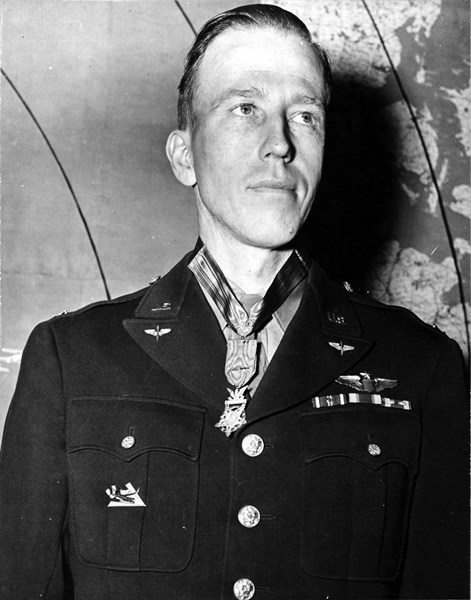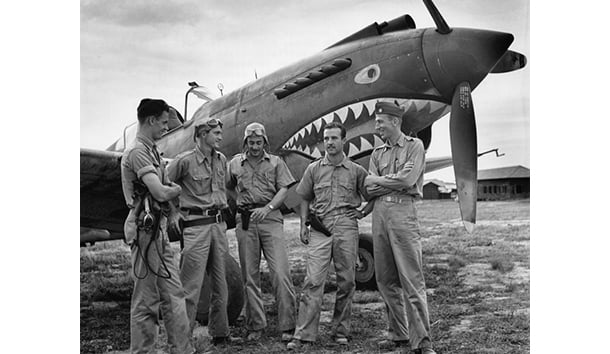One would think the only American fighter pilot to earn the Medal of Honor in World War II in Europe would be remembered and honored, or at least mentioned in history textbooks in high school and college. No such luck today. For those of us who grew up in the aftermath of the Second World War, however, this was fortunately not the case. The heroes of the war loomed large—in newspapers, magazines, books, newsreels, and movies. Their names were frequently dropped in conversations among adults, and their stories were passed on down to us kids. I was enthralled.
One of the first balsa-wood models I made was of a Curtiss P-40 Warhawk. I couldn’t read all the directions in the kit, but I could follow the illustrations. The final touch was  applying the decal of the shark’s open mouth on the front of the fuselage, an image that was ideally suited for the plane. I then had my own little version of the plane flown by the Flying Tigers in China and Burma. One of those Tigers was Jim Howard.
applying the decal of the shark’s open mouth on the front of the fuselage, an image that was ideally suited for the plane. I then had my own little version of the plane flown by the Flying Tigers in China and Burma. One of those Tigers was Jim Howard.
James Howell Howard was born in Canton, China, in 1913, to American parents. His ophthalmologist father was serving as a missionary, teaching Chinese medical students eye surgery. In 1927 the family returned to the United States, and Howard attended high school in St. Louis. After graduation he was off to California and enrolled at Pomona College in Claremont, intending to follow his father into medicine. After earning his bachelor’s degree, however, he thought he’d try Naval Aviation rather than medical school.
He excelled as an aviation cadet and by 1939 had earned his wings and was commissioned an ensign. His first duty was flying the Grumman F3F-2 biplane fighter with Fighting Six (VF-6) off the carrier U.S.S. Enterprise based at Pearl Harbor. Like many other pilots in the peacetime Navy or Army, Howard longed for more excitement, and when an offer came to join the American Volunteer Group in June 1941, he resigned his commission and became one of Claire Chennault’s boys. Howard signed on as a flight leader, which paid the princely sum of $650 per month plus $500 for every Japanese plane shot down. Howard liked the money, “But the overriding reason was my yearning for adventure and action.” He got all three.
Jim Howard and the other pilots rendezvoused at the Belmont Hotel in San Francisco during July 1941 and, in different groups, boarded passenger-carrying freighters operated by the Dutch-owned Java Pacific Lines during July and August. The pilots assumed various aliases and traveled as merchants, doctors, teachers, and missionaries.
The aliases were intended to fool Japanese spies, who were everywhere, including in the hotels and on the docks of San Francisco. Japanese spies were wise to it all, though, and Japan was able to track not only the pilots but also the planes they would fly—the P-40s—which were disassembled and shipped in cargo containers.

After nearly five weeks at sea, the ship Howard was aboard landed at British-held Rangoon in Burma. He and his fellow pilots then headed north to Toungoo, a remote airstrip in a jungle clearing. For two months the AVG pilots trained at the strip. The weather was miserable. Accidents were frequent. The pilots grumbled and several quit, and three died in crashes.
Spirits were lifted when Erik Shilling, a former Army test pilot, got the idea of painting a shark’s mouth on the P-40. A German squadron operating in the Mediterranean had first used the shark’s mouth on their Messerschmitts. When Shilling chalked out the mouth on the P-40, it looked far better than anything seen before, as if plane and design had been made for each other. Once paint was applied, the pilots were thrilled. “Looks mean as hell,” declared R.T. Smith, who would knock nine Japanese planes out of the sky.
By the end of November the pilots were divided into three squadrons, the 1st (Adam & Eves), the 2nd (Panda Bears), and the 3rd (Hell’s Angels). They would be stationed at both Kunming in China and at Mingaladon airfield near Rangoon. Howard was with the Panda Bears at Mingaladon. He saw his first combat action on January 3, 1942, when Jack Newkirk led him and Tex Hill in a raid on a Japanese airbase in Thailand. As the three Americans dove out of the sun it looked to them as if the taxiing Japanese planes—the Nakajima Ki-27 fighter (“Nate” in American code)—on the ground were preparing for takeoff. Actually, the planes had just returned from a raid of their own, and, unbeknownst to the American pilots, there were many more close behind on the way in.
Howard came swooping down on the airstrip at 250 miles per hour with his P-40’s 50-caliber guns blazing. The rounds were ripping into the planes below, but, as Tex Hill said, “Like lightning, one Jap tracked onto Jim Howard’s tail and was eating him up.” Hill banked steeply, got behind the Nate, and blew it out of the sky. Newkirk was doing the same thing at the same time to two other Nates at a higher altitude. The work of Hill and Newkirk allowed Howard to return for a second strafing run.
“I roared down the line of idling aircraft with my thumb on the firing button all the way,” said Howard in his memoirs.
The machine guns left a wonderful line of destruction the length of that array of fighters. I hauled back on the stick for the getaway. Nothing doing! As the nose came up, a dull thump shook my fighter. . . . Smoke poured from the cowling and the screaming Allison went dead. . . . I had been hit by ground fire.
Howard figured it was now a deadstick landing on the airfield or in the jungle. Either way the Japanese would have him, dead or alive. Just then the Allison coughed and sputtered, and sprang back to life. Then a second miracle. Two Nates were now nearby, but their pilots were evidently focused on the burning planes on the airfield below because, although they flew parallel to Howard, they took no notice of him. Fifteen minutes later Howard crossed the border into Burma and headed for Mingaladon. When he landed, 11 bullet holes were found in the fuselage and tail of his plane.
Howard continued flying in such heart-stopping action, first out of Mingaladon and then Kunming, until the Flying Tigers were disbanded on July 4, 1942. By then Howard was not only an ace with 6 1/3 kills but had destroyed many Japanese vehicles, facilities, and troops on the ground—all the while suffering intermittently from dengue fever. The Chinese decorated him with the Five Star Wing Medal and the Order of the Cloud and Banner.

Howard was offered a commission as major in the U.S. Army Air Forces should he choose to remain in China. However, he was so debilitated from dengue fever that he declined the offer and returned home to St. Louis to recuperate. Several months later and feeling fit, he traveled to San Diego to visit with old Navy comrades at the North Island Naval Air Station. He would have rejoined the Navy but had a bad meeting with the overbearing and dictatorial base commander. After all his combat in the Far East, Howard thought he didn’t deserve such nonsense and accepted the proffered commission from the Army.
He was sent not to China but to Muroc Dry Lake (now Edwards Air Force Base) and flew first the Lockheed P-38 Lightning and then the Republic P-47 Thunderbolt. By the late summer of 1943 he was commander of the 356th Fighter Squadron in the 354th Fighter Group based in England. Howard was excited to learn his unit would be getting a new fighter, the North American P-51 Mustang. “All of the advance rumors of the P-51’s excellence proved true,” declared Howard. “It was a fighter pilot’s dream.”
Through 1943 the U.S. had been losing large numbers of its long-range bombers, the B-17 and the B-24. No fighter carried enough fuel to fly all the way into Germany and back to England to guard the bombers while they were over targets in Germany, such as the Messerschmitt plant at Regensburg and the ball-bearing factories at Schweinfurt. The first raid on the two targets, in August 1943, saw German fighters shoot down 60 B-17s and damage another 47 so badly they had to be scrapped upon arrival back in England. In the second raid, in October, German interceptors blew 62 B-17s out of the sky.
Late in 1943 American fighters began to be equipped with auxiliary fuel tanks, greatly increasing the fighters’ range. The Mustang could now fly for 1,700 miles, enough for a round trip to Germany and back, including dogfighting over targets. P-38s and P-47s would now escort the bombers to the German border, where P-51s took over the duty. Jim Howard’s 356th Fighter Squadron was one of the units tasked with escort duty.
On January 11, 1944, the 8th Air Force launched 660 B-17s and B-24s in a massive raid against German aircraft plants at Oschersleben and Halberstadt. The 356th with Howard in command was one of the fighter squadrons protecting the bombers inside Germany. Over Oschersleben, Howard spotted Me 109s and Me 110s climbing to intercept the bombers, “like a swarm of bees.” Howard led his squadron in a dive into the midst of the swarm. He shot down one of the Messerschmitts and his boys destroyed eight more. The dogfight had drawn the Mustangs away from the bombers, though, and Howard hurried back to find some 30 German interceptors bearing down on them.
All alone, Howard hurled his P-51 into the enemy planes. In a few minutes of furious fighting he shot down at least four of the Messerschmitts—perhaps as many as six—and damaged others. Witnesses in the bombers thought the higher total was correct. Headquarters erred on the conservative side and credited him with four kills and two probables. No matter—in a daring solo action Jim Howard had broken up the enemy attack and saved the bombers. The lead pilot in the bomber formation, Maj. Allison Brooks, called Howard’s feat “the greatest exhibition I have ever seen.”
Gen. Carl “Tooey” Spaatz decorated Howard with the Medal of Honor, making him the only fighter pilot so honored in the European theater of war. Howard was promoted to lieutenant colonel and became commander of the 354th Fighter Group. He finished the war as a colonel with a total of 12 1/3 kills. In addition to the MOH, his decorations included the Distinguished Flying Cross (two awards), the Bronze Star, and the Air Medal (five awards).
Following the war, Howard was promoted to brigadier general in the reserves and developed a systems engineering business, Howard Research, which he later sold to Control Data Corporation. He retired to Florida and died there in 1995.

Leave a Reply